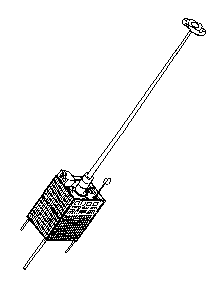 Spotlight On: UoSAT-OSCAR-22
Spotlight On: UoSAT-OSCAR-22
By: John A. Magliacane, KD2BD
[This article originally appeared in The AMSAT Journal,
Volume 15 No. 3, May/June 1992]
SPECS: Name: UoSAT-OSCAR 22 Object # 21575 Launch: 17 July 1991 Period: 100.24 Minutes Orbit: Polar LEO (Low Earth Orbit) Altitude: 775 km (482 miles) Height: 600 mm and 5 Meter Gravity Gradient Boo with 3 Kg tipmass Width: 300 mm Depth: 300 mm Weight: 46 Kg Modes: 9600 Baud FSK
UoSAT-OSCAR-22 is the most recent spacecraft in a series of Amateur Radio communications satellites designed and built by the Department of Electrical Engineering at the University of Surrey in Guildford, Surrey, England. UoSAT-OSCAR-22 was launched on July 17, 1991 on an Ariane rocket along with four "microsatellites", one of which is an amateur astronomy satellite called "SARA". UoSAT-OSCAR-22 is a multiple mission spacecraft designed to serve several audiences. One mission was to carry out experiments originally slated for UoSAT-OSCAR-15, whose on-board electronics failed shortly after the spacecraft reached Earth orbit . The primary purpose of UoSAT-OSCAR-22, however, was to provide non-amateur radio related store-and-forward digital communications for VITA and SatelLife, a non-profit, humanitarian organization. UoSAT-OSCAR-22's primary role in space has recently been modified when the satellite played a part in Amateur Radio's first "role reversal" with another spacecraft, UoSAT-OSCAR-14.
One of the most unique aspects of UoSAT-OSCAR-22 is its Earth Imaging System (EIS), designed by University of Surrey doctoral student Marc Fouquet. The Earth System was designed to capture Earth images from low-Earth orbit using a charge coupled device (CCD) camera, and broadcast those images to ground stations using amateur frequencies and the AX.25 packet radio "Pacsat Broadcast Protocol" when the spacecraft was not providing service to SatelLife. The monochrome CCD imager produces a CCIR video image having a resolution of 578x576 pixels with an aspect ratio of 4:3. Images taken by the CCD camera are first digitized using an 8-bit half-flash analog to digital converter, and then stored in RAM for later processing and transmission over the downlink transmitter. Received images can be captured and displayed using a personal computer with suitable graphics capability. The images can also be converted to popular GIF and JPEG formats and viewed in those forms if so desired.
[Here are several photos taken from UO-22 and converted to GIF format by Harold Price, NK6K. - N7HPR]
After some initial use, it became clear that OSCAR-22's CCD imager success and the less than optimum conditions on OSCAR-14 required that some operating changes to both UoSAT-OSCAR-14 and UoSAT-OSCAR-22 be made. Amateur stations around the world were downloading CCD Earth images several times per week, with each image containing more than 300 kilobytes of data. Furthermore, it was discovered that OSCAR-22's high power amplifier which produced excellent output on amateur frequencies, did not work reliably on the non-amateur frequencies used by SatelLife operations.
Taking into account the resources available and the obligations to SatelLife, HealthNet and VITA, UoSAT controllers decided to swap the roles of UoSAT-OSCAR-14 and UoSAT-OSCAR-22 in a attempt to optimize the capabilities and resources of each spacecraft. On February 5, 1992, all non-amateur traffic, both SatelLife and VITA, moved fro OSCAR-22 to OSCAR-14, which no longer transmits on its amateur downlink frequency. All amateur traffic moved from OSCAR-14 to OSCAR-22, and OSCAR-22 now operates as a dedicated amateur radio satellite transmitting constantly on its amateur downlink frequency.
Now that UoSAT-OSCAR-22 is operating exclusively in the amateur satellite service, the spacecraft can dedicate its 512 kilobytes of memory for storing as many as 800 packet messages. Two 9600 baud uplink receivers are available on frequencies of 145.900 and 145.975 MHz, and the single downlink transmitter on 435.120 MHz is available on a non-interrupted basis. The only minor inconvenience occurs when some users access the satellite to download CCD images while others connect just to check their mail. Solutions to these problems are being investigated by UoSAT controllers, while more efficient spacecraft operating software is developed to maximize the efficiency of UoSAT-OSCAR-22 operations.
Mode JD Downlink : 435.120 MHz, 9600 bps FSK
UoSAT-OSCAR-22 is currently the only 9600 baud store-and-forward packet radio satellite available for amateur radio use. [KO-23 and KO-25 have since joined the ranks of 9600 baud store-and-forward satellites - N7HPR] It is currently acting as a powerful gateway between widely spaced terrestrial ground stations, moving vast quantities of packet radio traffic around the globe in record speed. The 9600 baud packet link available on OSCAR-22 cannot be compared with the 300 baud "long haul" packet forwarding networks currently in use on the HF bands. OSCAR-22, and high baud rate packet radio satellites that follow in the lines of OSCAR-22, will go far in increasing the throughput and the reliability of the worldwide amateur packet radio (AMPR) network, especially in polar regions of the Earth where frequent auroral disturbances make HF operation unreliable.